
9 minute read
Safe Travels
Long-Haul Strategies
Most trailer trips are uneventful. But when you’re traveling long distances, you need to think and plan ahead. Here are 11 expert long-haul strategies.
Use these 11 expert strategies to help enhance your horse’s health and comfort on the road.
By Amy DeGeer Oberdorf Photos by Betsy Lynch
You probably think nothing of loading your horse in your trailer, shutting the doors, and taking off down the road. For most trips, the haul is uneventful. But when you’re traveling long distances, you need to think and plan ahead.
The stress and anxiety that your horse experiences simply by stepping onto your trailer can be greater than you think. When that stress occurs for an unusually long period of time, he becomes susceptible to health complications, such as dehydration, colic, physical injury, and pleuropneumonia (shipping fever).
But with proper preparation and forethought, and a solid travel plan, you can reduce the inherent risks of hauling your horse long distances. Here, Todd E. Shaarda, DVM, an equine practitioner in Grand Rapids, Michigan, and Curt Lange of Brook Ledge Horse Transportation in Oley, Pennsylvania, will offer their expert long- >>
haul strategies. Then they’ll give you tips on using leg wraps and coping with changing climate as you travel. Along the way, they’ll provide seven signs of sickness so you’ll know when to call a veterinarian.
Expert Strategies
Here are 11 measures you can take prior to and during long trips to enhance your horse’s health and comfort. 1. Think comfort. Make sure your horse has ample space in your trailer, preferably a box stall. Clean out manure and urine to reduce toxic fumes in your trailer. Train your horse to haul, and practice at home prior to the trip. 2. Get a health certificate. If your horse is healthy when he departs, he’s less likely to become sick during a long haul. A Certificate of Veterinary
Inspection (health certificate) verifies that he’s in good health. Plus, this certificate is required to cross state lines. You can obtain a CVI from any equine vet. 3. Boost his immune system. Dr. Shaarda suggests giving your horse a shot of an immune stimulator two weeks prior to your trip, and again one week prior, to boost your horse’s immune system. Also make sure your horse is current on his vaccination and deworming protocols. 4. Haul water. Since horses can get fickle on the road, bring water from home to encourage your horse to keep drinking. Even if he’s thirsty and wants to drink, he may not, because the water from the roadside gas station smells and tastes different. 5. Consider a water additive. “Some people add drink flavoring to the water,” says Lange. “If it works for your horse, go for it.” One popular additive is concentrated apple juice. 6. Pack an NSAID. Dr. Shaarda recommends keeping handy a tube of flunixin meglumine (brand name,
Banamine, a nonsteroidal anti-inflammatory drug that acts as a pain reliever), in case your horse suffers stomach pain, which could indicate colic. If you suspect colic, call a vet immediately. The Banamine is simply to help relieve your horse’s discomfort until you reach a vet. “Banamine also suppresses a fever,” Dr. Shaarda warns, “so take your horse’s temperature before you give it. Your attending vet will want to know if your horse has a fever.” 7. Make stops. Schedule rest stops at least every five hours, especially if your horse won’t eat, drink, urinate, or defecate in your trailer. Lange says that in Top: A half-hour rest stop with the motor turned off gives horses a chance to decompress. Although you would never travel with the windows open like this, during the break, the fresh air and view will do them good. Also, untie the horses and let them put their heads down to clear their airways. Bottom: Stop and check your horse at regular intervals, and to offer feed and water. Keep in mind that some horses won’t urinate in your trailer unless the vehicle is stopped and there’s bedding in the stall.
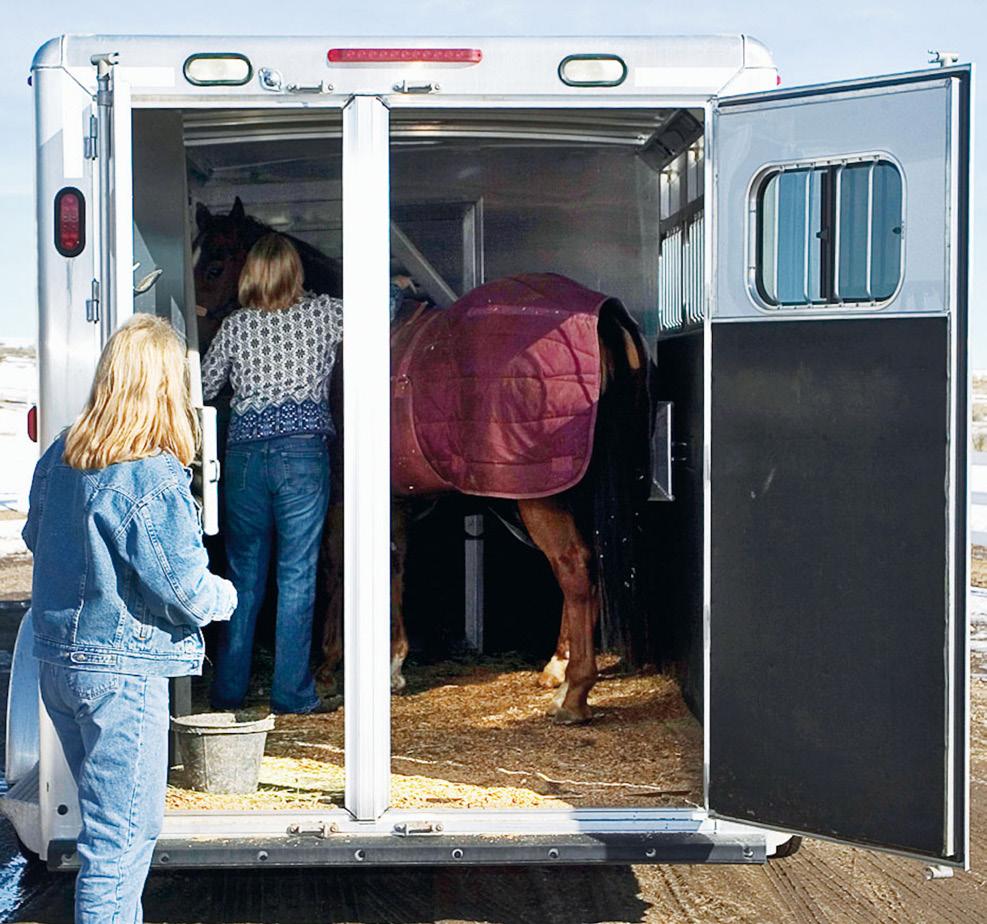
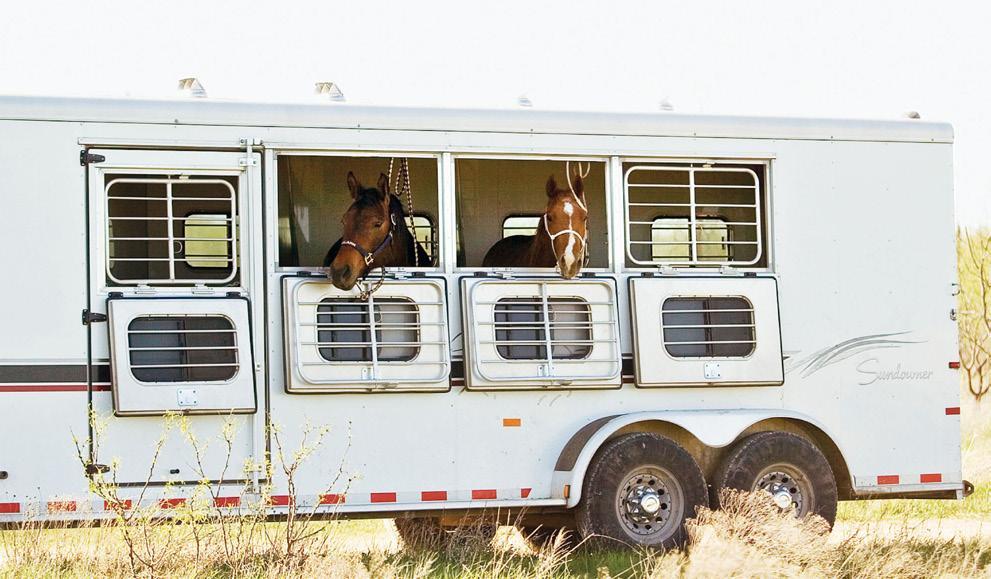
his experience, the rumble of an engine is enough to raise some horses’ anxiety. Simply turning off your tow vehicle may make a big difference for your horse, allowing him time to relax, urinate, and defecate. 8. Unload with care. Unload your horse every five hours if you can stop in a safe location, well away from roadways and hazards. But keep him in your trailer if loading and unloading is a stressor itself. 9. Untie him. During rest stops, untie your horse’s head so he can put it down to expel foreign matter easily. Pleuropneumonia, or shipping fever, is one >>
respiratory illness that stems from a horse’s head being tied in an “up” position during travel, combined with no rest stops. You can even leave your horse untied in your trailer if he doesn’t bother his travel buddies. 10. Check for dehydration. Dehydration can be harmful in and of itself, but it can also cause other problems, such as overheating, Dr. Shaarda explains. “If horses sweat too much, use an electrolyte replacement, and watch for other signs, such as depression.” Check your horse’s hydration level by pinching the skin on his neck; it should draw back tight against his body in two seconds.
If it stays out, then your horse is dehydrated; call a veterinarian. Excessive sweating is also a sign of dehydration. 11. Check respiration rate. “While at rest, your horse’s nostrils should not be flaring, and he should be at 8 to 12 breaths per minute,” says Dr.
Shaarda. “If he is over 22 breaths per minute, you need a vet.” A high respiration rate can be a symptom of several things, including dehydration, colic, and overheating.
Watch Leg Wraps
Wrapping legs is one of the most common things people do to prevent injury while hauling horses. But leg wraps can cause problems, especially quilts, polo wraps, and heavy shipping boots.
“[Polo] wraps fall down and the horses urinate on
7 Signs of Sickness
If your horse isn’t traveling well, he’ll show you. Below is a list of common behavioral reactions to stress that may indicate your horse’s health is compromised. If you see any of these signs, get your horse to a veterinarian as soon as possible.
• Decreased appetite. • Decreased water intake. • Repetitive pawing, kicking, licking, and/or scraping. • Biting or kicking at handlers. • A fever (above 101.5 degrees Fahrenheit). • Excessive sweating and overheating (a temperature of above 104 degrees F). • Flared nostrils, coughing, and nasal discharge.
Leg wraps can either be a blessing or a curse. Applied correctly and on horses used to wearing them, they can prevent leg injuries that occur all-too-often during transport. Shipping boots may be the safest option, says Dr. Shaarda.
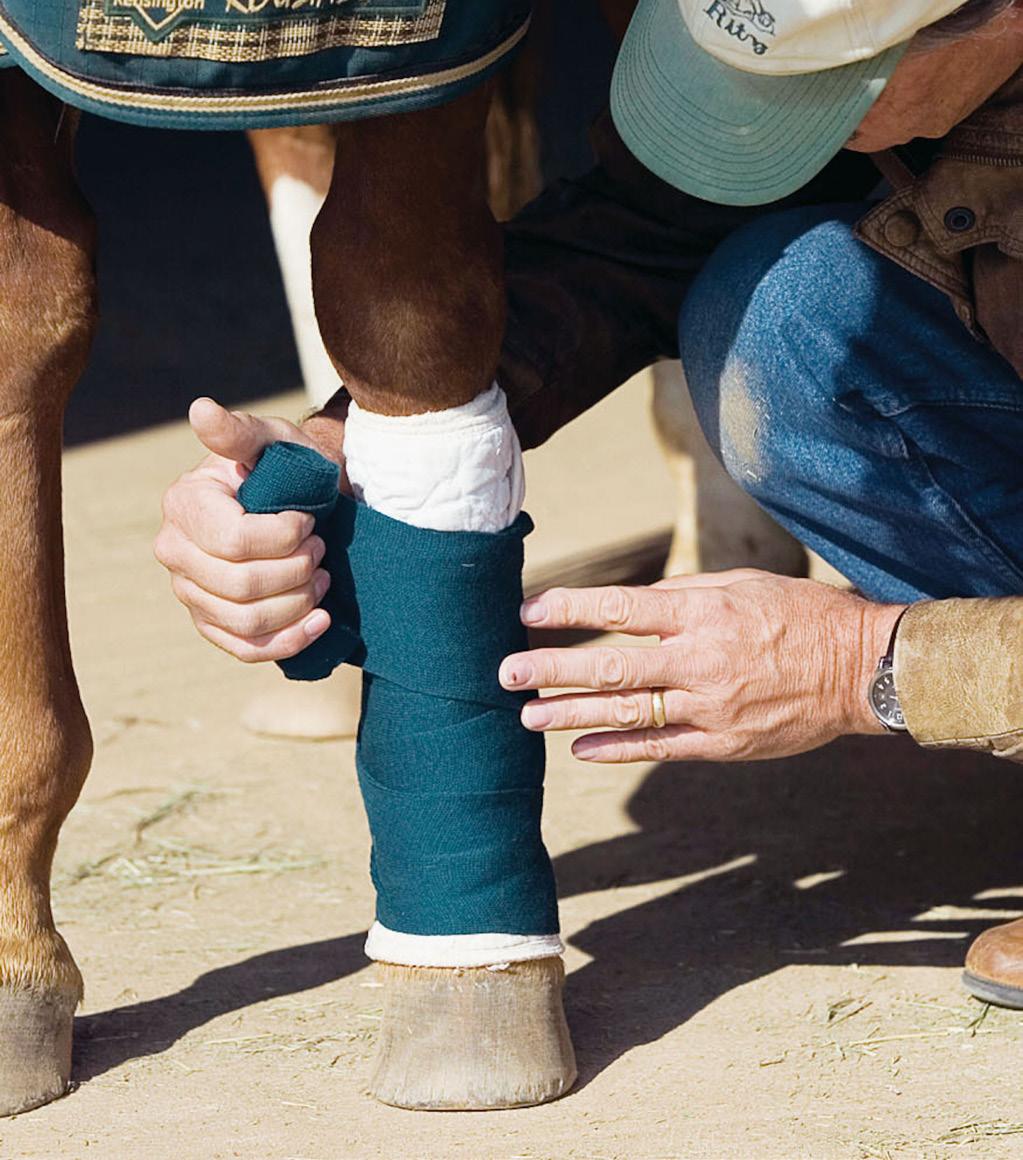
them, then they get stepped on,” Lange notes. “Eliminating wraps eliminates trouble.”
However, Dr. Shaarda sees a flip side. “I’m not a big fan of wrapping, but many of the wounds I’ve seen from trailering horses could have been prevented with wraps, especially in young horses,” he says.
If wraps are improperly applied, they can cord a tendon; that is, excess pressure can cause a minor inflammation at one spot in the tendon. Horses usually recover, but it tends to create a permanent thickening and damage to the tendon.
If wraps are too loose, they slide and flop around, which causes a horse to kick, creating injury risk to himself and others.
“Shipping boots may be the safest,” Dr. Shaarda says. “They can’t be applied too tightly, and they provide decent protection.”
Dr. Shaarda notes that good-fitting trailer mats with bedding for traction can also reduce the risk of leg injuries.
Consider Climate
“Horses are meant to be in the season,” Lange notes. “When you haul a winter horse south, don’t haul with
When your horse willingly steps into your trailer, he has no idea how long the trip will be. He’s simply putting his faith in you that you’ll take care of him every mile of the way. This poor horse arrived at her destination with rub wounds on both hips. She was confined in a too-tight compartment and made to travel too many hours without a break.
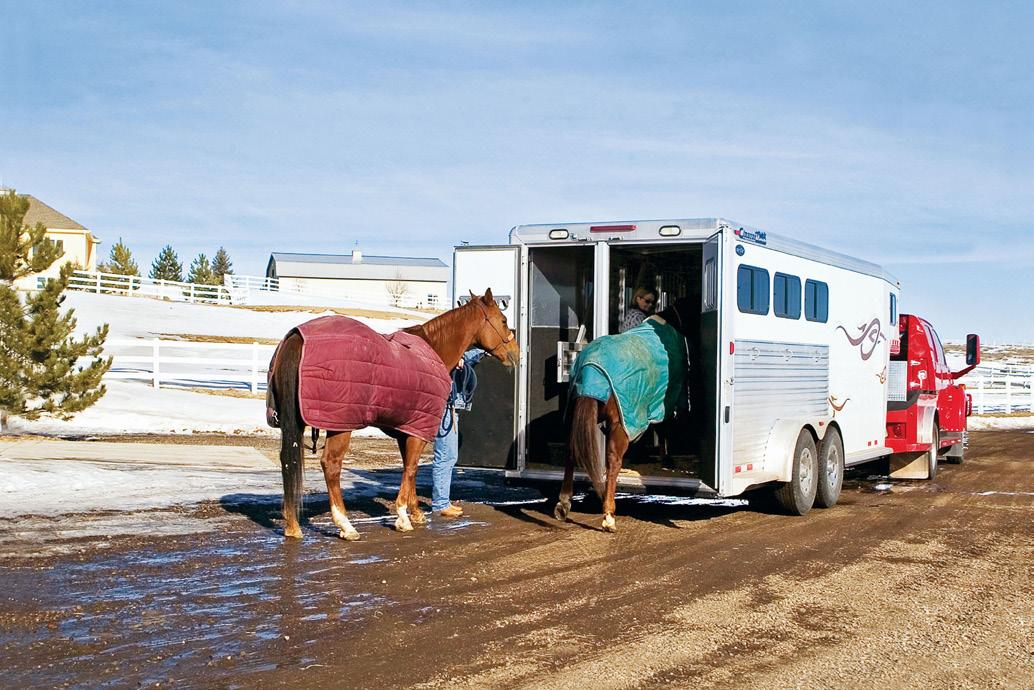
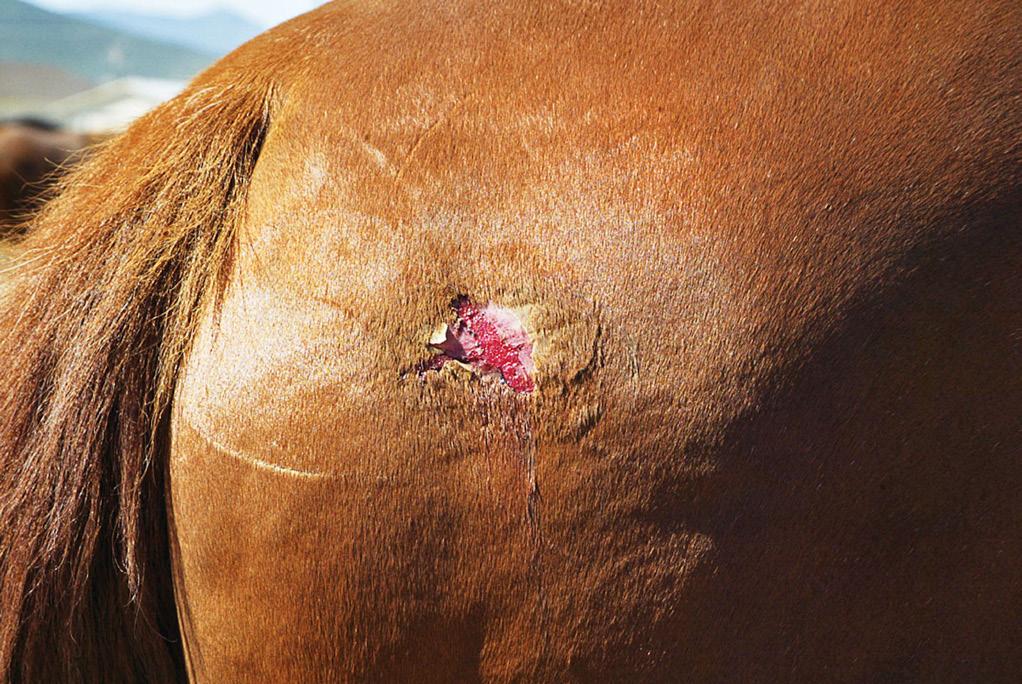
a blanket. At some point, you will have to wrestle with brought north in winter.” In his experience, these him to get the blanket off, and you could possibly get horses tend to develop pneumonia as they go from hurt.” being in fresh air to a closed-up barn where ventilation
Lange won’t ship a northern horse south, or is poor and toxic fumes are high. vice-versa, during extreme regional temperature If you’re hauling your horse north to south, he says, differences. In his experience, doing so increases the “Be ready to body clip, and let him adjust.” chance of sickness. Also note that if you’re hauling your horse from
“Some climate conditions are more of an issue a lower elevation to a higher one, give him time to when you get there,” Dr. Shaarda notes. “We see adjust to the change in altitude before you ask him to more problems with horses bought in the South and perform. USR Perfect THE Perfect THE
WAY TO BUY AND SELL HORSESWAY TO BUY AND SELL HORSES
GUARANTEED SATISFACTIONGUARANTEED SATISFACTION
“Great site. Very user friendly, very honest about “Great site. Very user friendly, very honest about the AQHA verification. I will always use this site. the AQHA verification. I will always use this site. Thank you for having such a great Web page.”Thank you for having such a great Web page.”
Zahl, North DakotaZahl, North Dakota

Equine.com is the fast and secure way to buy and sell horses, trailers and more. As one of the largest equine marketplaces, we sell an average of one horse every half hour. Equine.com is the fast and secure way to buy and sell horses, trailers and more. As one of the largest equine marketplaces, we sell an average of one horse every half hour. * The testimonial in this ad is an actual testimonial from Equine.com. The photo may not be a photo from the same ad as the testimonial. * The testimonial in this ad is an actual testimonial from Equine.com. The photo may not be a photo from the same ad as the testimonial. FOLLOW US: http://equine.com/FOLLOW US: www.Facebook.com/equine.comhttp://equine.com/ @equine_com www.Facebook.com/equine.com @equine_com







